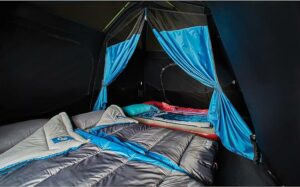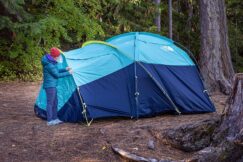When you’re lying in your tent at night, raindrops hitting your rainfly can be a welcome natural accompaniment. But if leaks come from within your tent, it quickly becomes an intolerable place to sleep. And the problem, condensation, may get into even the best-engineered shelter if the conditions are right.
Condensation forms when humid air comes in touch with a cold surface. On a hot day, nothing feels better than a frosty drink in your hand. An identical phenomenon can occur in a tent, with warmer air rising to the colder rainfly due to the difference in temperature between the interior and outside. It causes moisture to form on the underside of your rainfly. The water could soak the tent material or seep through the mesh windows.
How To Prevent Condensation In Tents

The solution to Tent Condensation
Condensation forms on the tent walls as the air cools at night while camping; this is because there is nowhere for the moisture to go. In that case, what can be done to prevent condensation from forming inside a tent?
Condensation inside a tent is something that can never be avoided entirely. Polyester is often used in modern tents due to its lightweight mobility and waterproof characteristics. However, polyester is not highly breathable outdoors.
However, there are still measures you may take to cut it significantly. The following advice is offered in the hopes that it will help you have a dryer tent and a more pleasant camping trip.
Tent condensation: what you can do about it
Let’s deep dive and find out the solution.
Ventilation
To keep the inside of your tent dry, you must provide adequate ventilation. Make sure nothing within the tent obstructs the upper and lower vents you may open.
It’s also a good idea to leave your tent doors open if the weather permits. However, the mesh area can stay sealed.
Adopt the proper stance when pitching
Additionally, orienting your tent, so the wind is blowing into it will increase the fresh air you bring.
As much as possible, pitch your tent on higher ground and away from low spots. You should also raise your tent far from any water to reduce the likelihood of a wet night.
Although scenic, setting camp close to water sources (such as lakes, rivers, and streams) will aggravate your condensation problems.
Bugs tend to congregate around water sources. Only a little fun can come from being a continual target of mosquito bites. If you’re going to be camping near water and can’t help yourself, stock up on effective bug spray.
If you can, set up a tent in a shady area (and safe). Thanks to the radiant heat, the tent’s walls won’t chill off quite as quickly.
Have a ground sheet ready
While tall, lush grass is aesthetically pleasing; it also acts as a sponge, which is problematic in a country like the United Kingdom. This problem is exacerbated in valleys because of the constant accumulation of chilly air, which makes the earth even more humid.
After finding a dry, shaded area to pitch your tent, throw down a ground sheet to prevent your tent from soaking up moisture from the wet ground.
Don’t cook inside the tent
If you can, it’s best to cook outside because the process generates a lot of steam. Keep your stove, oven, or other cooking appliance as close to the door as feasible if you must cook indoors because of poor weather.
This is better since it prevents condensation from forming inside the tent and is safer.
Dump damp items outside the tent
Don’t take off your damp clothes and leave them inside your tent if you want them to dry quickly. Condensation forms and escapes from clothing when they dry. Allowing them to remain inside the tent will only raise the humidity.
To avoid this, you can use a dry pack to keep your wet items safe and dry. They don’t cost much and can prevent a lot of trouble.
Keep your hands away from the edges
Water seeps through when pressure is applied to the walls. Keep your clothes, gear, and bags from touching the tent walls if possible. This may be tough in a small tent with little space.
If we’re setting up camp close to our vehicle, we’ll store whatever isn’t an absolute must in the trunk. We appreciate the space-saving feature in our tiny two-person tent.
Avoid using any heating appliance
One surefire way to ruin your camping experience is to be uncomfortable in your tent due to the cold. Even still, there are better options than carrying a heater along. There will be more condensation if the tent is heated. There is an increase in both perspiration and evaporation when exposed to high temperatures. Instead, ensure you have a good sleeping bag, enough warm clothes, and extra layers if the temperature drops.
Use microfiber towels
Unfortunately, condensation will occur no matter how careful you are. The best way to keep your tent in good condition during your camping trip is to bring along a high-quality microfiber towel and use it frequently to clean it. Doing so can prevent excess moisture from accumulating and causing problems.
The tent should be dried after use
You should consider drying your tent before storing it away to reduce the moisture it will absorb on your next camping trip. Condensation problems are almost guaranteed to worsen if you leave a damp tent crumpled in its bag until your next trip.
Is this condensation or a leak in my tent?
A leaking tent is a common analogy for condensation. Unless your tent is poorly made, it is exceedingly unlikely that any water will get inside. If water collects in the same place repeatedly, that’s evidence of a leak; otherwise, it’s probably just condensation.
Conclusion
Your rainfly is rarely completely dry in the morning, but if you follow these guidelines, the rain should stay on the outside where it belongs.



